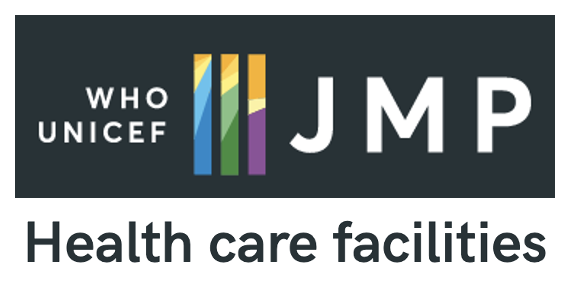| Standard Profile
|
| Name
|
Joint Monitoring Program (JMP): WASH in Healthcare Facilities (HCF)
|
|
| Sector
|
Water Sanitation and Hygiene (WASH)
|
| Creator
|
WHO and UNICEF
|
| What the standard measures
|
WASH services in health care facilities in all contexts
|
| Priority indicators
|
- Basic water services: Proportion of health care facilities where the main source of water is an improved source, located on premises, from which water is available
- Basic sanitation services: Proportion of health care facilities with improved and usable sanitation facilities, with at least one toilet dedicated for staff, at least one sex-separated toilet with menstrual hygiene facilities, and at least one toilet accessible for users with limited mobility.
- Basic hygiene services: Proportion of health care facilities with functional hand hygiene facilities available at one or more points of care and within 5 metres of toilets
- Basic health care waste management services: Proportion of health care facilities where waste is safely segregated in consultation areas and sharps and infectious wastes are treated and disposed of safely.
- Basic environmental cleaning practices: Proportion of health care facilities which have protocols for cleaning, and staff with cleaning responsibilities have all received training on cleaning procedures.
Indicator details are elaborated in this Core Questions and Indicators for monitoring WASH in health care facilities in the Sustainable Development Goals document.
|
| Links to SDGs
|
3, 3.8,
6, 6.1, 6.2
SDG indicator definitions are explained in this document.
|
| Key users of the standard
|
- Health Care Facilities
- Global health organizations
- Health development sector organizations (non governmental organizations, civil society organizations, faith based organizations, private sector)
|
| How users analyze data
|
| Water
|
Sanitation
|
Hygiene
|
Health care waste
|
Environmental cleaning
|
Advanced service
To be defined at national level
|
Advanced service
To be defined at national level
|
Advanced service
To be defined at national level
|
Advanced service
To be defined at national level
|
Advanced service
To be defined at national level
|
Basic service
Water is available from an improved source located on premises.
|
Basic service
Improved sanitation facilities are usable with at least one toilet dedicated for staff, at least one sex-separated toilet with menstrual hygiene facilities, and at least one toilet accessible for people with limited mobility.
|
Basic service
Functional hand hygiene facilities (with water and soap and/or alcohol- based hand rub) are available at points of care, and within 5 meters of toilets.
|
Basic service
Waste is safely segregated into at least three bins and sharps and infectious waste are treated and disposed of safely.
|
Basic service
Basic protocols for cleaning available, and staff with cleaning responsibilities have all received training.
|
Limited service
An improved water source is within 500 meters of the facility, but not all requirements for basic service are met.
|
Limited service
At least one improved sanitation facility, but not all requirements for basic service are met.
|
Limited service
Functional hand hygiene facilities are available at either points of care or toilets, but not both.
|
Limited service
There is limited separation and/or treatment and disposal of sharps and infectious waste, but not all requirements for basic service are met.
|
Limited service
There are cleaning protocols, or at least some staff have received training on cleaning.
|
No Service
Water is taken from unprotected dug wells or springs, or surface water sources; or an improved source that is more than 500 m from the facility; or the facility has no water source.
|
No Service
Toilet facilities are unimproved (pit latrines without a slab or platform, hanging latrines and bucket latrines), or there are no toilets or latrines at the facility.
|
No Service
No functional hand hygiene facilities are available at either points of care or toilets.
|
No Service
There are no separate bins for sharps or infectious waste, and sharps and/or infectious waste are not treated/disposed of.
|
No Service
No cleaning protocols are available, and no staff have received training on cleaning.
|
| Source: UNICEF and World Health Organisation (2018). Core questions and indicators for monitoring WASH in Schools in the Sustainable Development Goals. Geneva: UNICEF and World Health Organization.
|
Service levels and priority indicators are monitored at national, regional, and global levels.
|
| How users act on data
|
Data is used to:
- Strengthen national policies, standards and national development plans
- Ensure sufficient financing and staff capacity to manage WASH in HCF
- Use risk-based approach to prioritize and maintain improvements
- Monitor Sustainable Development Goals (SDGs) progress / other global commitments
- Compare HCF WASH services nationally, regionally and globally
- Influence public perception on national and global HCF WASH service statuses
|
| How users create reports aligned with the standard
|
Reporting is coordinated at the country level by national statistical offices and key sector institutions (i.e. ministries of health and medical services, regulators of sanitation and hygiene services). Tabulation guidance is explained in detail on page 13 of the Core questions and indicators for monitoring WASH in health care facilities in the Sustainable Development Goals document.
|
| Where users submit reports
|
Reports are submitted to national statistics offices and health authorities responsible for SDG monitoring and reporting. Harmonized national, regional and global baseline estimates are conveyed in the Global Baseline Report 2019 for WASH in Health Care Facilities.
|
| Languages in which standard is available
|
English
|
| Standardized survey template(s)
|
Coming soon
|
| Digitized in Akvo Flow
|
Coming soon
|
| Excel versions of Standardized surveys
|
Coming soon
|
| Standardized data visualization dashboards
|
Coming soon
|
| Standardized Survey Profile Form (SSP)
|
Coming soon
|
| Date standard was last updated
|
2020
|
| Current version of standard (# or name)
|
Not versioned
|
| Source
|
https://washdata.org/monitoring/health-care-facilities
|

